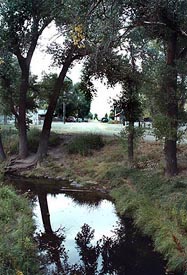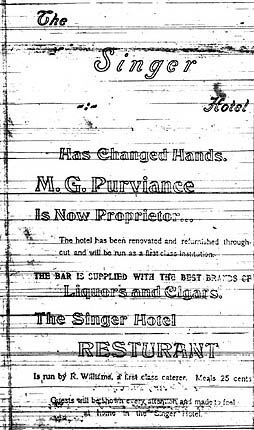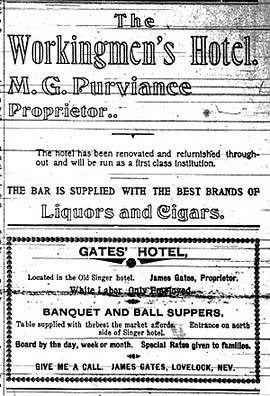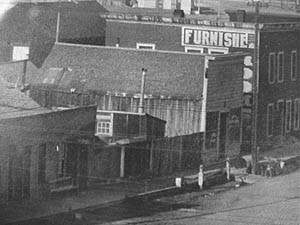
It was the fall of 1898 the Purviance family in Paradise Valley was looking for a new place to live and work.
Louise Purviance's family, the Daveys, no longer resided in Paradise Valley. Louise's sisters, Julia and Bessie had both married, as had her brother James Davey. Flora Davey was the last sister to marry. It would be Lovelock that Edna Purviance would always remember as her childhood home... |
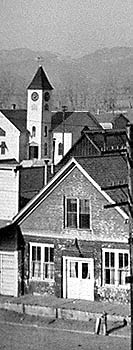 |
Lovelock Home The story of Edna Purviance’s Lovelock Home Research by Linda Wada © - October 21, 2004 Editing - Wes Wada Part Two - The Singer Hotel Purviances and Nurnbergers In late September, The Lovelock Tribune quoted a man as saying “This is the liveliest town I have struck”. That man was Madison Gates Purviance, Edna's father. Madison appeared to be looking for a new place to call home. That same September his oldest daughter, Bessie Purviance just entered Reno University. He easily could have been returning from Reno when he stopped in Lovelock to check it out. Lovelock was being praised as the new boomtown in the area. It was picking up steam by the late 1890’s as a dairy center for Nevada. The area also boasted good farming, excellent ranchland, and promising prospects for mineral wealth from the nearby mountains. |
|
Madison Purviance was apparently looking for a new start, as well as a place that would be nearer to Bessie in Reno. Lovelock was 110 miles closer to Reno compared to Paradise Valley, and there was no need for stagecoach travel. Lovelock was about 100 miles northeast of Reno, all by train.
The family moved to Lovelock around Thanksgiving of 1898. They were listed as staying in the Big Meadow Hotel before renting a house in the area. Their stay at the Big Meadow Hotel next to the Lovelock train depot ironically was only one block north from their what would be their future home. The family found what they were looking for when an announcement in the January 1899 Lovelock Tribune noted that M.G. Purviance was finishing remodeling, and was moving his family into the Singer Hotel.
I am still researching whether the report of 20 rooms was true, but if correct, they had to be quite small. Also in the hotel was a saloon facing West Railroad Street on the ground floor, a cafe in the back along 5th Street, several hotel rooms located on the second floor, and a residence in the center of the building. The cafe appears to have been an addition after the main hotel building was built. The cafe is the only part of the building without a second floor, but is mentioned by one source as having a root cellar. The building itself was about 23 feet wide by 85 feet long on a lot that was 25 feet wide by 130 feet deep. The Singer Hotel included Lots 18, 1 and 2 in City Block 14 in Lovelock. The hotel was on the corner on Lot 18 facing Railroad Street and along 5th Street. Lot 1 had some outbuildings and corrals and faced ‘C’ Street on the corner of 5th and ‘C’ Street. Lot 2 appeared to be mainly a bare lot facing ‘C’ Street. The location was ideal for a hotel. It was only one block south of the Lovelock Train Depot. According to one drawing of the layout of the building in 1904, the saloon had no doors into the main structure. It only had the one entrance facing West Railroad Street. (This information came from a drawing from an state historical archive in Nevada. The drawing had no information who or why the drawing was created, so I am only reporting what the information revealed.) The Purviances did lease the hotel the first year for $30 per month with an option to buy. Most likely, they wanted to test their new business before fully committing to a purchase. As for the cafe, the family would lease this part of the business over the years. Madison managed the bar in the beginning. (Learn more about the history in the Madison Gates Purviance Story.) Option to Buy In August of 1899, George Singer’s wife fell seriously ill and Singer may have needed money for medical care. He decided to sell the Singer Hotel and the Lots 1 and 2 with it. Madison apparently did not have the money to buy, so Singer sold it to Mrs. C. Bastian. During his first year leasing the hotel, Madison reported good business, and apparently gained enough to exercise his option to buy in December of 1899. Madison bought the hotel property for $1650. The loan to buy the hotel came from B.F. Lynip. Lynip, who came from San Francisco, was a well-known and respected schoolmaster at the Big Meadow School. He was also very active in Humboldt County business. (see more on Lynip's - The Contract) In the spring of 1900, Madison decided to make changes since the family now owned the hotel. He and neighboring business owners decided to freshen the appearance of the block. His neighbors were his brother in law Lester Piper, who had his newly built Piper Hardware Store on Lot 16 in the fall of 1899, and William O’Leary, who had his dry goods store right next to the hotel on Lot 17. They planted 20 trees around the properties, cleaned, painted, and in general made the block look much more attractive. The local newspaper was quick to comment how nice that section of town was looking. Piper and O’Leary placed new signs on their businesses, and Madison did the same. While the other signs were noted, Madison’s new sign created a stir. Madison changed the name of The Singer Hotel to The Workingmen’s Hotel and Bar. George Singer was well known in Lovelock, and The Singer Hotel was a landmark in town so the new name didn't set well with the locals.
Leasing out much of the business allowed Louise and Madison more time for other interests. Louise, it was time for her daughters, her music, and her church activities. For Madison, well, he still had the bar to manage, but not for long… By December 1900, the Workingmen’s Bar was leased to James B. Carmichael and his partner, Young. Young stayed with the business for about one year, before leaving to pursue other interests. Carmichael would lease the bar until the spring of 1902. Also in December, a tragic event occurred. Lessee Jim Gates died from catarrh of the stomach. He had thyroid fever for nearly a month before his death, which weakened his health. His wife Cora, continued to lease the cafe and rent hotel rooms during the following year. But changes would be many in the next two years… The Purviance Divorce In 1902, the marriage (The Purvaince Divorce) of Madison and Louise Purviance came to an end. According to Louise Purviance’s divorce complaint, the main reasons for the split were Madison’s drinking and gambling, and the possible chance of losing their Lovelock home and business. Louise won custody of her two minor age daughters, Edna 7 and Myrtle 17. She also easily won rights to all the Lovelock property. She did not own the property, but managed to restructure the debt. She was able to help pay off B.F. Lynip’s loan. Louise sold all the property to The L. Zunini Family. Zunini now owned the 'papers' on the property, which met Louise owed Zunini the balance due on the business. Zunini was a friend to both the Purviances and the Piper family (Lester Piper was Louise’s brother in law, who had Piper Hardware on Lot 16.) Needing more money, Louise decided to sell Lot 2, the undeveloped lot facing ‘C’ Street, to Zunini. She would never own that lot again. Zunini would have a store at that location until he left Lovelock. With the divorce over, Louise’s holdings were down to two lots (Lot 1 and Lot 18 in City Block 14.) Louise still had a huge debt to pay off, at least she still had her home. Mrs. Louise Nurnberger In December of 1902 after the divorce, Louise would continue to lease the cafe and bar, but seemed to run the hotel rentals herself. The year and a half after the divorce was probably the most frugal time Louise and Edna had in Lovelock. But that would change in the fall of 1904. Louise married a well-known and respected businessman Robert Nurnberger. The event was a very quiet one as the couple married in San Francisco, where Robert’s family lived. The marriage seemed to be a good match for Louise and meant a stable life for both Edna and Louise for the next six years. How the couple met is not clear, but Robert had a successful plumbing business in Lovelock at the time of the marriage. They both attended Lovelock’s Methodist Church, about a block southwest of the hotel. (This is the white church we saw the first night we were in Lovelock.) From all my research, Robert was a quiet, serious minded individual devoted to work and family. He was also involved with projects to help the town and his church. One of his favorites was his interest in creating a local fire department with underground water pipes around town to help in fighting building fires. Not a bad idea for the plumbing business either, but he voiced his real concern about the lack of fire fighting equipment. Lovelock, typical of western towns, would suffer from many fires through its history.
Nurnberger also changed the basic look of the main hotel building. He removed the wood awning over the sidewalk and expanded the upstairs with a new dormer on the north side of the building. Whether he extended this to the south side, I do not have the evidence or photos to see clearly, but in looking at the 1910 photos of the building, there is a possibility of this being the case. The hotel name changed too. In about 1906, the name Workingmen’s Hotel and Bar was replaced with Central Lodging and Bar. While the bar and cafe name would continue to have different names over the years, Central Lodging or Central House were the names that stuck the longest. Adobe was yet another name attached to the business. In the end, the Singer Hotel name would never return, and the property would nearly sell yet another lot. In 1907, the Nurnbergers decided to lease the land of Lot 1. Mr. and Mrs. Charles Rea wanted to build a hotel and liked the location of Lot 1 in City Block 14. The Nurnbergers drafted a contract, with the most noteworthy clause being that no saloon was to be run in the building. Soon after the Reas built a two-story hotel called the Alaska Hotel right beside Nurnberger’s plumbing shop. The Alaska Hotel was on the corner of ‘C’ Street and 5th. It faced ‘C’ Street. The plumbing shop faced north onto 5th Street. The Alaska Hotel would be established for many years to come, but Robert Nurnberger’s Plumbing Shop was seeing its last days… The Illness and a new start, again... In May of 1910, Louise’s married life would once again take a tragic turn as Robert Nurnberger turned suddenly ill. Robert's health slowly deteriorated, and he would never recover. During the summer of 1910 to help pay for medical bills, the Nurnbergers leased Robert’s plumbing shop to Truckee, California plumber George Wilkerson. The Purviances also sold Lot 1 with the Alaska Hotel to the Reas. By Christmas of 1910, the family pretty much knew the end was near for Robert. In early January, Louise and Robert Nurnberger took their final train ride together to Oakland, California. Robert spent his last days with Louise in the Bay Area. On February 7th, 1911 Robert died in Oakland, California.Upon receiving the news, Edna took the train to Oakland to be with her mother. The two stayed in Oakland until the end of March, but returned to Lovelock to start anew, once again. |
Meanwhile, on Lot 17…
But by 1907 a new mining town was drawing much attention. Rochester, Nevada was fast becoming the new boomtown. Frank Baker decided to try his luck there, but still kept Lot 17 and leased the building. I am still doing more research on the Lot during these early years, but to date the first business I found after the Bakers Store closed was called the French Laundry. This business can be clearly seen in the 1910 photo of Lovelock. This photo is important in the fact one can clearly see what the building on Lot 17 looked like in 1910. In looking closely at the windows alone, the building on Lot 17 seemed to not have changed much in the front over the years, but I will come back to this later. The French Laundry continued its business at Lot 17 well past the time Edna left Lovelock to live in San Francisco in the summer of 1913.
For a few short years the history of the type of business in the building on Lot 17 gets a bit hazy. The tax records continue to show the building as having a saloon at the location, but other information shows it could have been another laundry. And a lady renting from Louise could have started that laundry… |
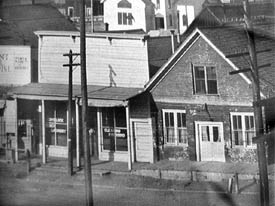 This shows the Lovelock French Laundry on the left and Louise's Central Lodging (boardinghouse) on the right in 1910. The small section of building on the far left was Piper Hardware Store. Lester Piper sold the store about 1907 to L. Zunini. 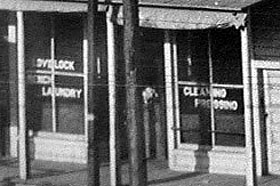 Sorry for this being hard to read clearly in this jpg, but very clear in the original photo. This a close-up of the Lovelock French Laundry in 1910 on Lot 17, right next to Louise's Central Lodging broadinghouse on Lot 18. |
Back to Top
All other content Copyright 2003-2016 - Edna Purviance, ednapurviance.org Research Collection
Linda Wada, WadaWorks, All Rights Reserved
including photos and newspaper articles from public and private collections.
Special thanks to the official county offices and libraries from Humboldt and Perishing County.
